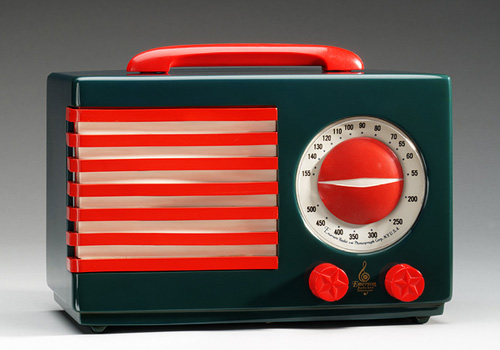
Image Credit: The Metropolitan Museum of Art
Before creating the “Patriot” radio, Norman Bel Geddes had long been involved with traditional, cabinet radio design. And while many of his cabinet radios follow the robust, furniture-esque aesthetic common to radios of the day this radio, created for the New York World Fair, 1939, breaks that mold. The “Patriot,” rather than simply blending into the décor of a room, forcefully makes itself known. This radio, rather conspicuously, embodies a particular patriotic flair. Most prominently, it features the seven red and six white stripes of the United States flag. Its knobs feature stars, and in most models red, white, and blue are the predominate colors.
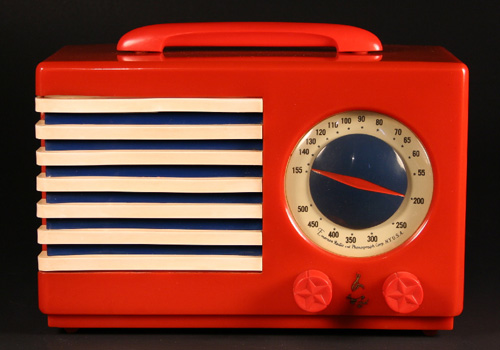
Image Credit: Tube Radio Land
It would be unfair, though, especially in retrospect, to label the “Patriot” radio as something like nationalistic kitsch. Even if it was produced in order to “create an optimistic and useful emblem of American technology, industry, and identity” (Heilbrunn Timeline of Art History) it carries with it an unabashedly forceful design that cannot be brushed aside. Rather than merely carrying the trappings of or a symbol for a nationalistic spirit this radio operated, specifically as an object, to promote itself more than any nationalism. So that while a flab might be mobilized to act as mere symbol this radio carries with it more weight. And unlike the various wood-paneled cabinet radios that worked to hide themselves, to blend into parlors, the “Patriot” radio works actively captures a user’s attention. The music it relays becomes a sideshow.
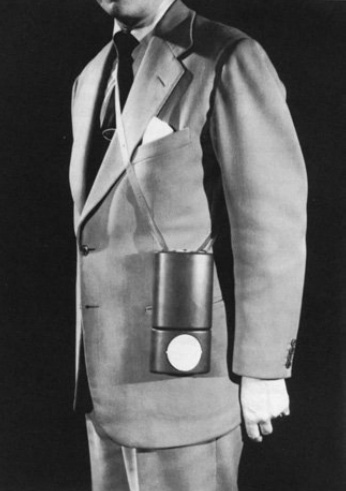
Image Credit: The Harry Ransom Center
Geddes also designed a portable shoulder radio for Philco in 1946. This predates the mass production of transistor based devices by roughly ten years. That it still relied on vacuum tubes rather than the significantly smaller transistors accounts for its relative size. Even taking tubes into consideration, though, this shoulder mounted radio imagines a future where music is nearly ubiquitous. In some ways, though, this imagined future isn’t ours. While our current musical commonplace is almost painfully private—headphones on every head and earbuds in every ear—Geddes’ shoulder radio trends toward both a publicly embodied object and a public sound. The radio, with its brilliant white speaker, draws the eye, so that publically it works on multiple senses. It presents mobile music and spectacle both, and we can begin to see this radio as the ancestor to the shoulder mounted boom boxes of the eighties.
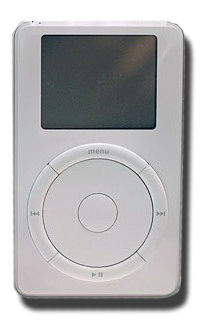
Image Credit: Wikipedia
Turning toward our current musicscape, though, and the exceedingly common iPod (and its progeny) there’s a vastly different design principle in play. These devices are conspicuously inconspicuous. For all of their sleek lines and glossy screens and solid weight they shrink away as objects. Instead, they present themselves, present their use, as accessories, devices, prosthetics for a particular attitude. They work exactly as they should, beautifully when used how they are intended to be used, but they do so underhandedly. These are objects that bottom from the top.
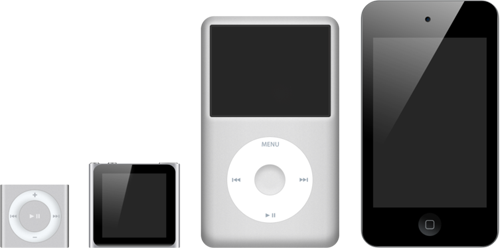
Image Credit: Wikipedia
Upending the familiar hierarchy of use these objects become the users and the humans are cast as device. And while it isn’t anything uncommon for human’s to be used by objects—I think the case could be made that the outcome of good design is that the human user becomes the used—the iPod, especially, and its descendents are particularly pernicious in their deception. They order not only a specific relation between object and human but organize a breadth of relations. Our encounters with music (economically, situationally, emotionally, environmentally) are shaped now, in large part (whether or not you use an iDevice), by the force of Apples music player. And they do it by simply tucking into things—your pocket, palm, car, stereo, desk. They elide their own presence and appear as nothing more than a ‘natural’ extension to an already configured human body.





Recent comments
2 years 29 weeks ago
2 years 44 weeks ago
2 years 44 weeks ago
2 years 50 weeks ago
3 years 4 weeks ago
3 years 4 weeks ago
3 years 4 weeks ago
3 years 6 weeks ago
3 years 6 weeks ago
3 years 6 weeks ago